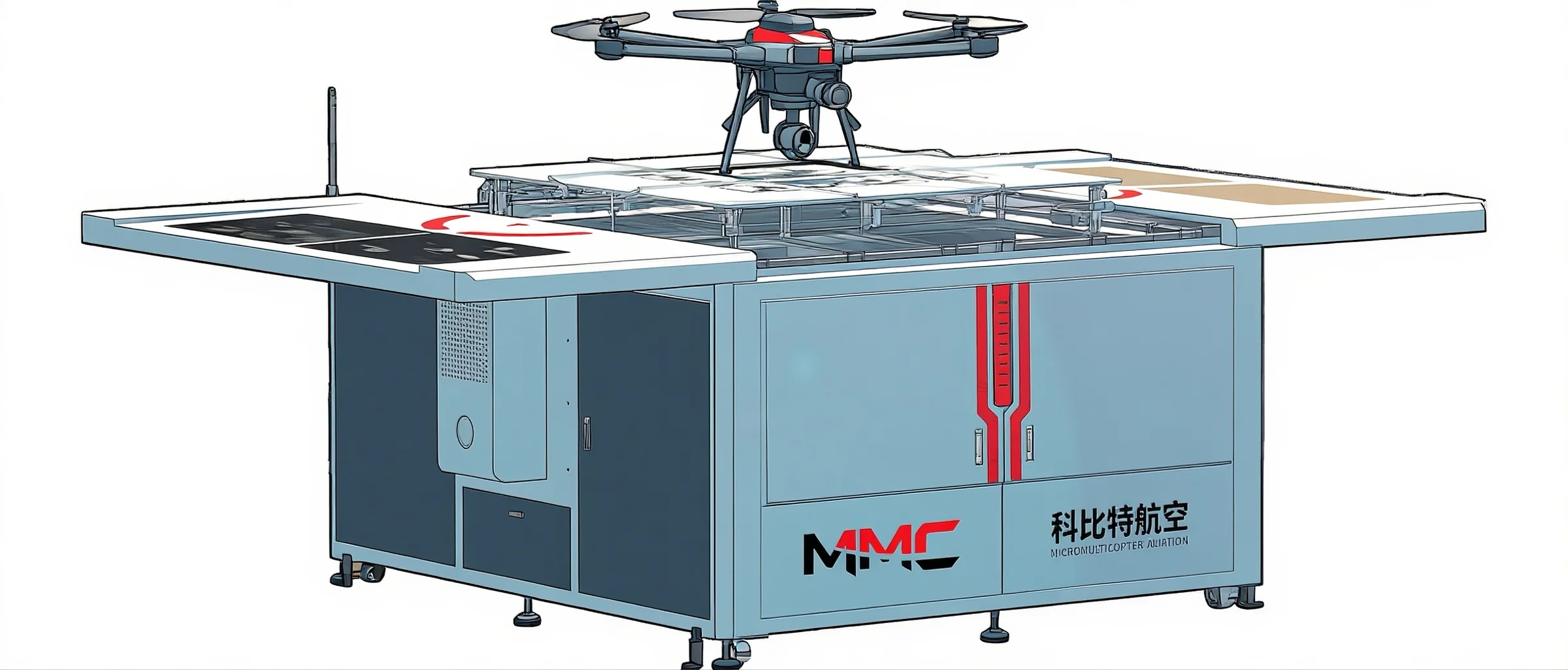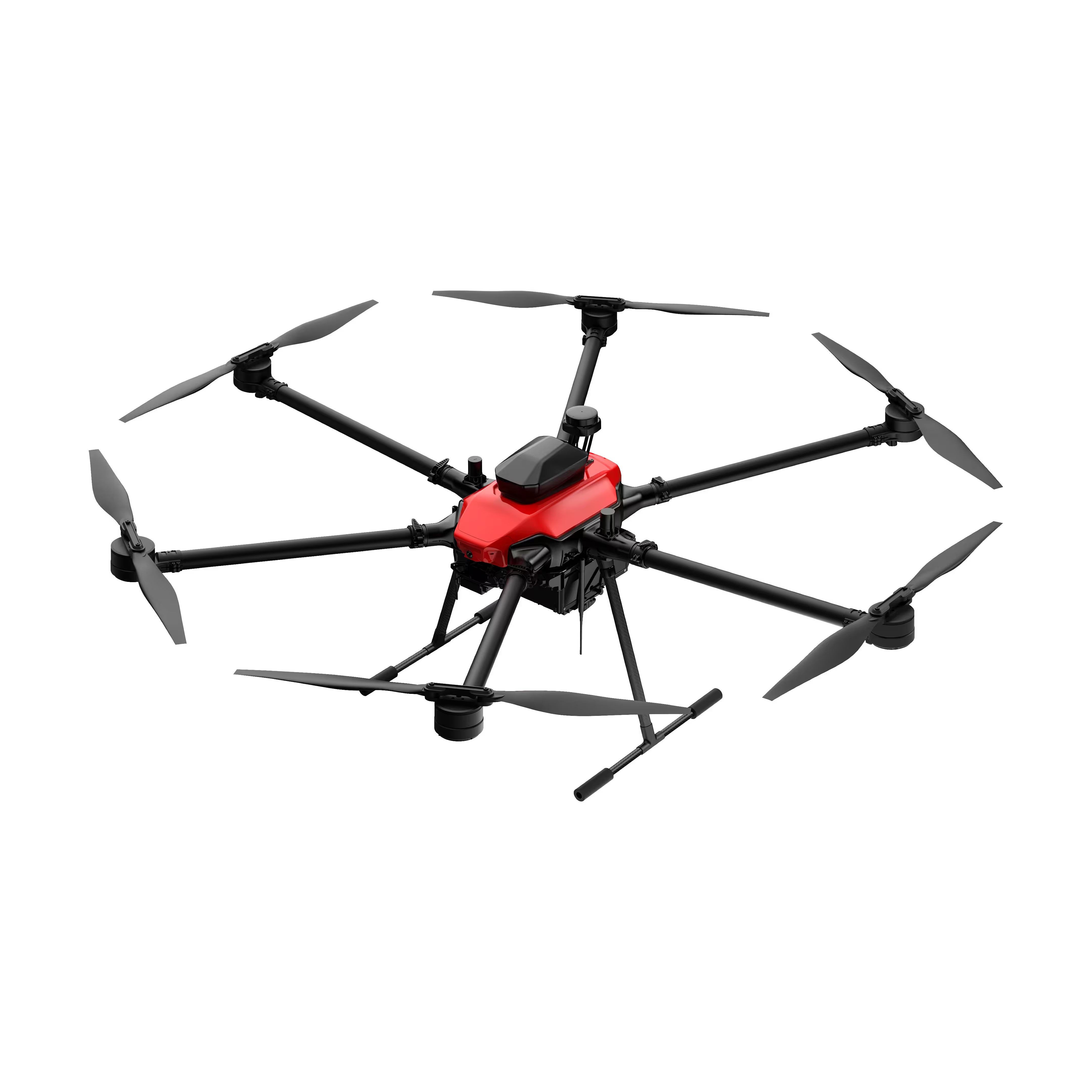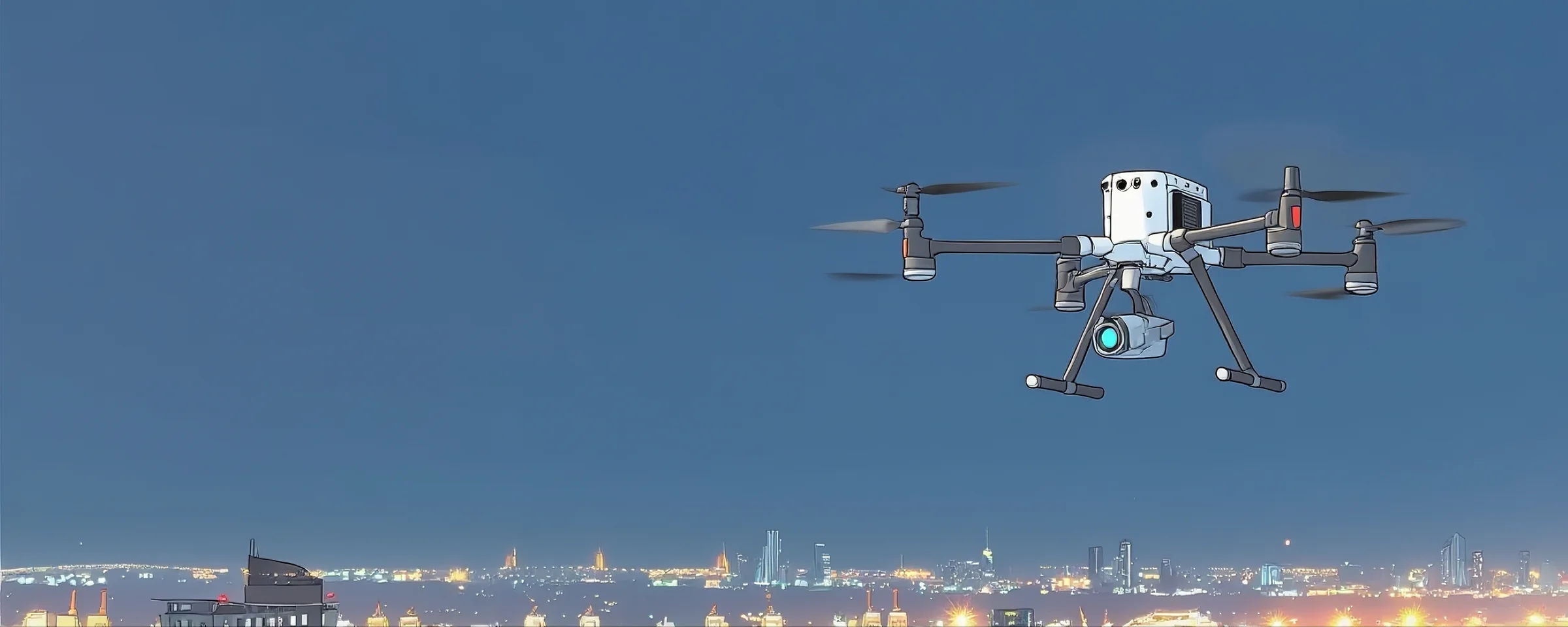First Response
MMC’s First Response solution uses drones to cut response times, deliver real-time intel, and boost safety through fast, autonomous DFR operations for law enforcement.
Painpoints
- – Unreliable incident information leads to unprepared ground teams and inefficient resource distribution.
- – A lack of manpower in law enforcement departments and large travel distances between incidents leads to delayed response times.
- – Police officers often have to navigate between different roles, leaving little time for drone operations.
Advantages
- Drones arrive at the incident first, helping to assess the situation so that command centers can allocate resources accordingly.
- Strategically deploy drones to cut down on response times and to evaluate the urgency of the response needed by ground teams.
- Reduce drone integration friction and increase drone availability by integrating drone-in-a-box solutions for Drone as First Responder Programs.
Solution

Automated Drone as First Reponder
- Thermal and visual sensors to gather comprehensive aerial intel for your missions.
- Compact and lightweight design, easy to deploy in urban environments with limited space.
- Fast and easy deployment, get airborne in around 45 seconds.
- Fly-to missions to optimize flight response.
- Manual controls for developing situations that require human intervention.
- Reduced operational risk with the Task Area Management feature.
Drone Platform

Skylle Ⅱ
Hexacopter Industrial Heavy-Lift Drone - 10kg Payload | 60min Flight Time | RTK cm-Level Positioning | IP54 Rated Read More
Learn MorePayload And Software
MMC Marstation Drone Box Ⅱ: Automated Drone as First Responder—Redefining Speed and Intelligence in Law Enforcement
In law enforcement first response, every second counts. When emergencies strike—whether active shooter situations, missing person cases, or traffic incidents—delayed ground units risk lives and escalate threats. The MMC Marstation Drone Box Ⅱ transforms first response by deploying automated drones as the first on scene, delivering real-time aerial intelligence before ground teams arrive. Designed to integrate seamlessly into urban landscapes, this solution accelerates first response, enhances situational awareness, and empowers officers with critical data to make split-second decisions.
45-Second Deployment: First Response Takes Flight Faster Than Ever
The cornerstone of effective first response is speed—and the Marstation Drone Box Ⅱ sets a new standard. With fast and easy deployment, it launches an automated drone in just 45 seconds from activation, eliminating the delays of manual drone prep or waiting for human pilots. For law enforcement, this means aerial support is airborne before ground units reach the scene, providing an immediate bird’s-eye view of threats, victims, or hazards.
In active shooter scenarios, this 45-second head start lets commanders assess building layouts, identify suspect locations, and coordinate entry strategies—directly enhancing first response outcomes. For missing person cases, the drone can rapidly scan large areas, using thermal sensors to detect body heat even in dense foliage, turning hours of ground searches into minutes of targeted action.
Multi-Sensor Intelligence: Comprehensive Data for Informed First Response
First response demands more than just visuals—it requires actionable intelligence. The Marstation Drone Box Ⅱ is equipped with thermal and visual sensors, working in tandem to gather comprehensive aerial data critical for law enforcement missions. During daytime, the high-resolution visual camera captures clear imagery of suspects, crowds, or vehicle details, while the thermal sensor cuts through smoke, darkness, or obstructions to reveal hidden heat signatures.
At night or in low-light conditions, thermal imaging becomes indispensable: detecting individuals in shadows, identifying overheating equipment in industrial emergencies, or locating trapped victims in structural fires. This dual-sensor capability ensures no detail is missed, providing first response teams with a complete understanding of the scene to prioritize actions—whether deploying rescue teams, isolating threats, or redirecting traffic.
Urban-Ready Design: Clustered Deployment for City-Wide Coverage
Cities and urban areas present unique challenges: dense infrastructure, limited space, and the need for rapid coverage across neighborhoods. The Marstation Drone Box Ⅱ addresses these with its compact and lightweight design, featuring a reduced installation footprint ideal for clustered deployment. Installed on rooftops, police stations, or public facilities, these drone boxes create a network of automated first responders, ensuring no area is more than minutes away from aerial support.
In a sprawling metropolis, this clustered approach means a drone can be dispatched to a downtown incident from a nearby box while another responds to a suburban call—maximizing efficiency. The small footprint also eliminates barriers to deployment in space-constrained urban environments, ensuring first response aerial support is always within reach, when and where it’s needed most.
Adaptive Flight Modes: Autonomy and Control for Dynamic First Response
First response scenarios are rarely static—what starts as a routine call can escalate into a complex situation requiring human judgment. The Marstation Drone Box Ⅱ balances automation with flexibility, offering Fly-to missions for pre-programmed, optimized first response routes and manual controls for evolving incidents. For standard first response tasks—such as traffic accident documentation or perimeter surveillance—the drone autonomously follows pre-set flight paths, ensuring consistent data collection without human input.
But when situations demand adaptability—like a suspect fleeing or a victim moving—the system switches to manual control, letting trained operators take over to track targets or adjust viewpoints. This hybrid approach ensures first response is both efficient (via automation) and agile (via human intervention), adapting to the unpredictability of real-world emergencies.
Task Area Management: Reducing Risk, Enhancing Safety
First response must prioritize officer and public safety—and the Marstation Drone Box Ⅱ’s Task Area Management feature minimizes operational risk. This tool lets commanders define no-fly zones, altitude limits, and safe flight corridors, ensuring the drone operates only in designated areas. In urban, this prevents collisions with buildings, aircraft, or crowds, while in sensitive scenarios (e.g., school zones or hospitals), it ensures compliance with privacy and safety protocols.
By reducing the risk of accidents or mission disruption, Task Area Management lets first response teams focus on the crisis at hand, confident the drone is operating safely. For law enforcement, this means aerial support enhances first response without adding new liabilities—turning the drone into a trusted, low-risk partner in critical situations.
Conclusion: The Future of Law Enforcement Is Automated
By deploying automated drones as first responders, it slashes response times, delivers real-time multi-sensor intelligence, and adapts to the chaos of emergencies with autonomy and human control. For law enforcement departments, this means faster, smarter, and safer first response—turning “arriving on scene” into “already knowing what’s happening.”
Elevate your first response with the MMC Marstation Drone Box Ⅱ: where automation meets action, and every second of first response counts.

Versatile Aerial Response
- Robust and weatherproof airframe graded IP55, allows you to fly when is most needed.
- Night Scene Mode and NIR Auxiliary Light features for night operations.
- Optimal operational efficiency with extended flight time of up to 55 min.
- Transmission range up to 20km to cover larger response areas¹.
- Hot-swappable batteries for continuous operation.
- Expandable payload capabilities with speakers, spotlights, and other PSDK options.
Drone Platform

Skylle Ⅱ
Hexacopter Industrial Heavy-Lift Drone - 10kg Payload | 60min Flight Time | RTK cm-Level Positioning | IP54 Rated Read More
Learn MorePayload And Software
MMC Skylle Ⅱ: Versatile Aerial Response for Law Enforcement—Adapting to Every Crisis with Speed and Intelligence
In law enforcement first response, versatility isn’t just an advantage—it’s a necessity. From active shooter situations to missing person searches, from traffic accident reconstruction to crowd control, first response teams face unpredictable scenarios that demand adaptable tools. The MMC Skylle Ⅱ emerges as the ultimate versatile aerial response solution, combining multi-sensor intelligence, rugged reliability, and flexible payloads to meet the dynamic needs of first response. Designed to be the “swiss army knife” of aerial support, it ensures first response teams have the right data, tools, and coverage to act swiftly and decisively, no matter the crisis.
Multi-Sensor Payload: The Intelligence Backbone
At the heart of the Skylle Ⅱ’s versatility lies the Thyea HT18R payload, a tri-camera system integrating zoom, wide, and thermal sensors to deliver 360-degree situational awareness for first response missions. The high-resolution wide camera captures expansive scene context, critical for mapping incident perimeters or monitoring crowd movements during large-scale first response. The powerful zoom camera enables detailed reconnaissance from a safe distance—ideal for identifying suspects, license plates, or hazards without compromising officer safety.
When darkness, smoke, or foliage obscure visibility, the thermal camera takes over, detecting heat signatures to locate missing persons, trapped victims, or hidden threats. This sensor fusion ensures first response teams never fly blind: whether day or night, clear or obscured, the Skylle Ⅱ transforms raw imagery into actionable intelligence, empowering faster, more informed first response decisions.
IP55 Weatherproof Ruggedness: First Response Flies On, Regardless of Conditions
Rain, dust, or extreme temperatures can’t halt emergencies—and they won’t halt the Skylle Ⅱ. Its IP55-rated airframe is built to withstand harsh elements, ensuring aerial support remains operational when first response needs it most. In stormy conditions, when ground units may face delays, the Skylle Ⅱ continues to gather data, tracking suspects or monitoring flood zones.
In dusty urban environments or industrial areas, its sealed design prevents debris from disrupting sensors or mechanics, maintaining reliability during critical first response. For law enforcement, this ruggedness means first response aerial support is never “grounded”—a lifeline in scenarios where weather could otherwise blind first response teams to evolving threats.
Night Operations Mastery: Extending First Response Into the Dark
Many emergencies strike after dark, and first response can’t afford to lose momentum when the sun sets. The Skylle Ⅱ excels in low-light first response with Night Scene Mode and NIR (Near-Infrared) Auxiliary Light, turning darkness into an advantage. Night Scene Mode enhances image clarity in starlight or moonlight, preserving fine details like facial features or vehicle identifiers.
The NIR Auxiliary Light illuminates targets with invisible-to-the-naked-eye infrared light, allowing the drone to track subjects without alerting them—critical for stealthy in hostage situations or suspect pursuits. Together, these features ensure first response teams maintain uninterrupted aerial coverage 24/7, eliminating “darkness gaps” that could delay rescues or allow threats to escalate.
Extended Flight Time & Hot-Swappable Batteries: Sustained Aerial Presence
First response missions rarely conclude in minutes—and neither should aerial support. The Skylle Ⅱ delivers up to 55 minutes of flight time on a single battery, ensuring prolonged coverage for extended first response scenarios, such as large-scale searches or ongoing incident monitoring. When missions demand even longer presence, hot-swappable batteries enable continuous operation: swap depleted batteries in seconds, with no need for complex recharging setups.
For law enforcement, this means first response aerial support can stay airborne for hours, tracking evolving situations, relaying updates to ground teams, and ensuring no critical moment is missed. In missing person cases, this sustained presence can mean the difference between a successful rescue and a tragic outcome—making the Skylle Ⅱ a vital tool for first response endurance.
20km Transmission Range: Wide-Area First Response Coverage
First response often spans large or remote areas, from sprawling urban neighborhoods to rural landscapes. The Skylle Ⅱ’s 20km transmission range ensures aerial intelligence reaches command centers even in expansive environments, keeping first response teams connected to critical data. Whether monitoring a highway pileup from miles away or tracking a suspect fleeing into rural areas, the drone maintains a stable link, relaying real-time video and sensor data to guide ground units.
This extended range eliminates “dead zones”, ensuring even the most remote incidents receive the aerial support they demand. For agencies managing large jurisdictions, this means fewer drones are needed to cover more ground—maximizing first response efficiency and resource allocation.
Expandable Payloads: Tailoring First Response to Every Scenario
Versatility in first response means adapting to the unexpected—and the Skylle Ⅱ’s expandable payload capabilities make it ready for any mission. Beyond its core sensors, it supports PSDK (Payload Software Development Kit) options like loudspeakers for crowd announcements or suspect warnings, spotlights for illuminating dark areas, and even emergency supplies delivery for stranded victims. In active shooter situations, a loudspeaker can issue verbal commands to protect civilians; in search-and-rescue, a spotlight can guide ground teams to a heat signature detected by the thermal camera.
This modularity ensures the Skylle Ⅱ isn’t just a drone—it’s a customizable first response platform, tailored to the unique demands of each incident.
Conclusion: Skylle Ⅱ—The Versatile Workhorse of Law Enforcement
The MMC Skylle Ⅱ redefines versatile aerial response by combining multi-sensor intelligence, IP55 ruggedness, 24/7 operation, extended flight time, long-range transmission, and expandable payloads into a single, powerful solution. For law enforcement first response teams, it’s more than a tool—it’s a trusted partner that adapts to every crisis, delivers critical data when seconds count, and ensures first response is always one step ahead.
Equip your first response with the MMC Skylle Ⅱ: where versatility meets urgency, and every mission gets the aerial support it demands.